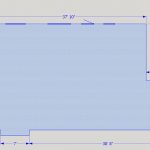 Measuring square footage of a home is not as easy as it sounds. Do you measure the outside of the foundation and include it in the finished square footage? In this brief article, I’ll cover some of the basics of the various methods of measuring, as well as definitions of how we use square footage in our MLS systems.
Measuring square footage of a home is not as easy as it sounds. Do you measure the outside of the foundation and include it in the finished square footage? In this brief article, I’ll cover some of the basics of the various methods of measuring, as well as definitions of how we use square footage in our MLS systems.
Measuring Methods
ANSI Z765-2003
The American National Standards Institute (ANSI) has a published paper about measuring square footage, which they call floor area. This document is called the ANSI Z765-2003.
In this document they talk about how they define their standard way of measuring a home, which includes how to include stairways, whether a protruding window (bay window) is included, what is above grade, how to deal with sloped ceilings, kneewalls, open staircases, etc. This method is not widely known in the real estate industry as only some people use this method. The National Association of Home Builders (NAHB) recommends this standard.
Appraisers, although they may follow ANSI guidelines, report sqft in Gross Living Area, or Gross Building Area. This measurement of area may be different than the ANSI standard, depending on the local customs.
Assessors usually will be following a standard, but sometimes they don’t actually measure. They may take the drawings to be accurate, while the builder may have changed the actual building slightly. Or there may be an addition where there never was a permit pulled and the assessor didn’t know about it.
Keep in mind that whatever the measuring method, PEOPLE are involved in the process and PEOPLE can make mistakes, or interpret something differently than others.
Square Footage Definitions
In our local Minneapolis / St. Paul / Twin Cities market, we have several fields for square footage measurements and some cities have other measurements as well. But for the most part these are the relevant measurements:
Sample House measurements from MLS:
Foundation Size: 2,024
AbvGrdFinSqFt: 4,533
BelGrdFinSqFt: 1,306
Total Fin SqFt: 5,839
Foundation sqft
This is the area enclosed by measuring the outside of the foundation, where the foundation is the structure that supports the house above it. The reason this measurement gets complex is does the foundation include a tuck-under garage?
Some areas will allow for the garage to be included in the foundation size. Others will not want this to be included in the foundation size. Locally, I have seen it both ways, so with a little detective work, one can figure out how the foundation size is accurately represented.
In the case of my house, my tuckunder is included in the foundation measurements according to the city records.
Above Ground Finished Sqft
This measurement is of all “finished” spaces that reside wholly above ground. Finished spaces mean that they are habitable spaces that are to code, and have appropriate heating / cooling systems in place, meaning that they are conditioned spaces. Above Ground means that the floor level has to be entirely above grade. So split level homes may only have 2 of the 3 (or 4) levels above grade.
On houses that have more than 1 level above ground, it would include all the space that is finished, including the space inside the walls, and the hallways, and closets. If you have a 2 story house with the garage on the main level, but have a bonus room above the garage, this would also include the bonus room space.
Technically the measurements of “finished” spaces require a 7 foot ceiling height, at least according to the ANSI way of measuring a house. But frequently we see many 1.5 story houses in Minneapolis and St Paul measured to the kneewall.
Below Ground Finished Sqft
This is again “finished” spaces, but only for spaces that have the floor level below the outside ground. So finished basements, or levels 3 (or 4) on split level houses.
Sometimes on houses we see a foundation of 1200 and a Below Ground Finished SQFT of 1200, this usually cannot be correct. There needs to be some space for the utilities such as the furnace and water heater. Usually those are not in “finished” spaces.
Total Finished Sqft
This measurement is easy. This is the sum of the above ground sqft, and the below ground sqft.
Another Example
Same House measurements from Minneapolis City Records:
Building Area(+ Basement): 6,352
Ground Floor: 1,953
Second Floor: 2,446
Basement Area: 1,953
Finished Basement: 457
Building Area + basement
This is the entire sqft that is enclosed by the house, whether finished or unfinished.
Ground Floor
Minneapolis calls the first level as “Ground Floor.” Sometimes this may include the upper level of a split level home. This number would reflect finished sqft on one level (or a combination of 2 of the split levels).
Second Floor
On two or more story homes, this includes everything that is finished and above the ground floor. You would have to add the “Ground” and “Second” to get the MLS Above Ground Sqft.
Basement Area
Same as Foundation Sqft.
Finished Basement
Same as Below Ground Finished Sqft.
Comparison
Without going through this particular home, these numbers from MLS are very close to the city assessors numbers. This indicates that either the agent measured the home (and pretty accurately), or they hired someone to measure, or they used measurements off an appraisal. Either way, it is very close.
The lower level space however differs quite a bit. My speculation would be that the added more finished sqft in the lower level and Minneapolis didn’t update their records (if a permit was pulled).
| Measurement | MLS | Minneapolis |
| Foundation Size: | 2,024 | 1,953 |
| AbvGrdFinSqFt: | 4,533 | 1,953+ 2,446 = 4,399 |
| BelGrdFinSqFt: | 1,306 | 457 |
| Total Fin SqFt: | 5,839 | 4,399 + 457 = 4,856 |
Why does this matter
There two main reason that accurate finished sqft matters.
1. buyers look at sqft
2. appraisers
Buyers look at square feet measurements
There are many buyers that look at sqft measurements when they are searching for a home. I have very often seen a 1.5 story house that has a foundation of 1100 sqft (which means the first floor is probably also 1100), with a total Above Ground Sqft of 1800. This means either one of 3 things. 1. There may be a family room addition off the back on the main level. 2. There may be a raised-roof addition that makes this house really a 1.75 story home. 3. They inflated the numbers by either measuring incorrectly, or just inflating the numbers.
This hurts the industry as it presents a non-professional sales technique into the mix. Buyers that then see the house wonder how they ever came up with 2600 sqft.
Appraisers look at square feet measurements
Appraisers will usually measure a house that they are evaluating. But when it comes time to compare it to other houses, do they measure those houses? No, because those comparable houses are typically already sold, and they won’t have access to them.
So when sqft is wrong in MLS and an appraiser uses that data, it hurts other comparable sale appraisals.
